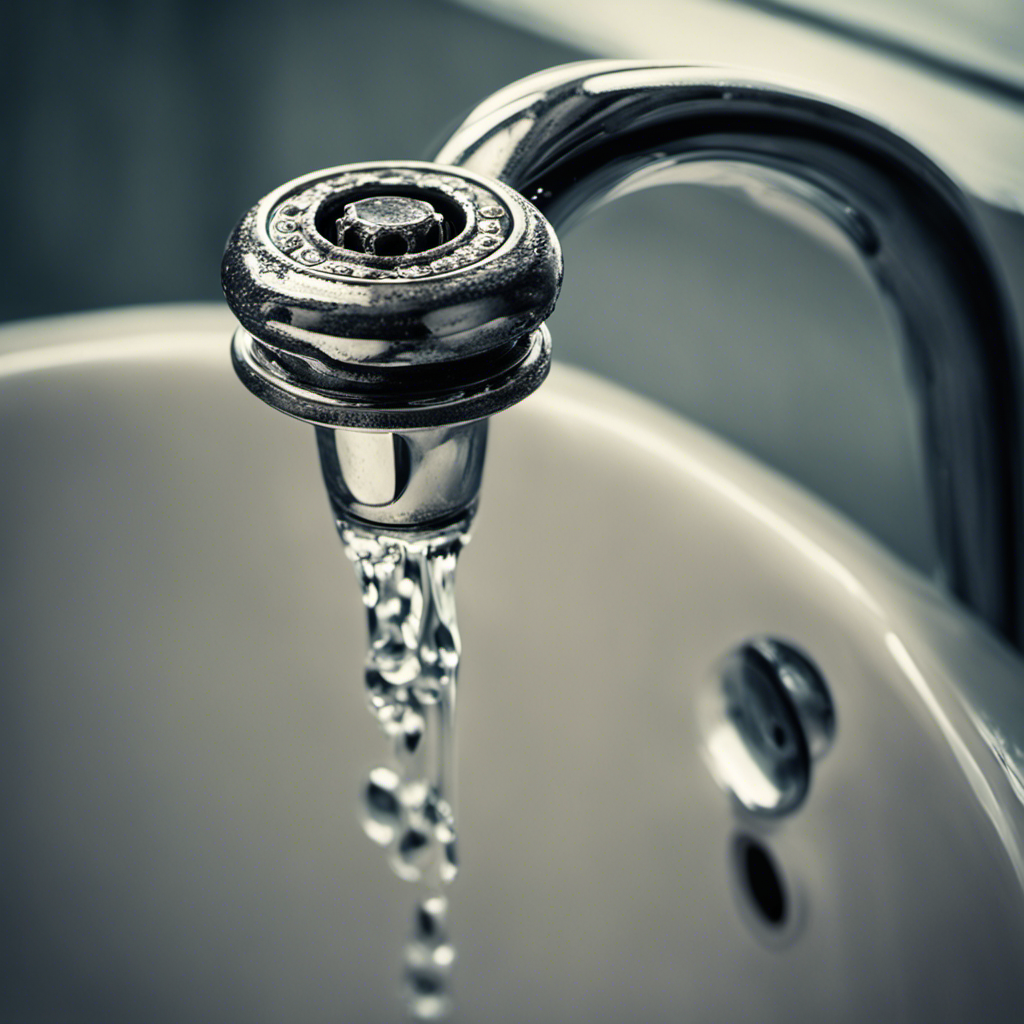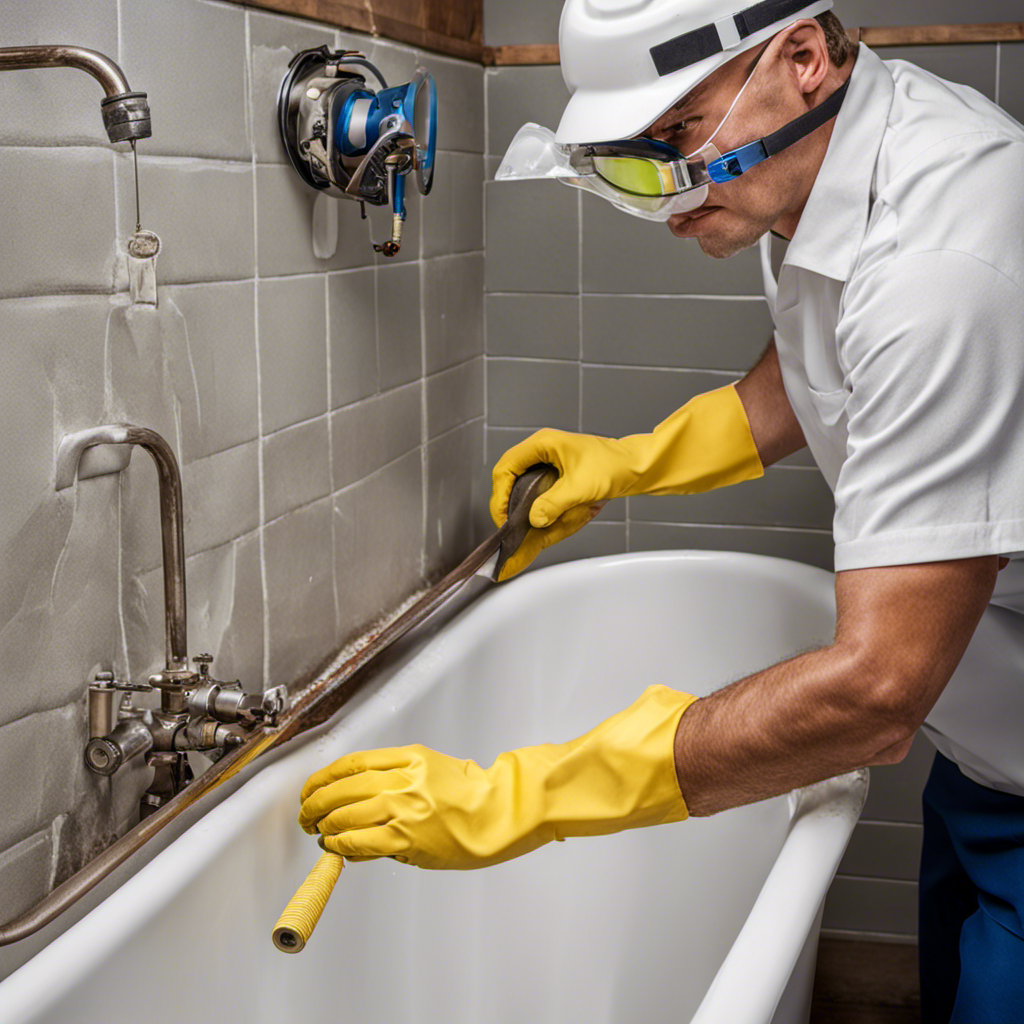Are you tired of struggling with your old bathtub faucet handle? Well, guess what? Changing it is easier than you think!
In this article, we will guide you through the step-by-step process of replacing your bathtub faucet handle. By following our precise and detailed instructions, you’ll be able to give your bathroom a fresh look and enjoy the convenience of a brand new handle.
So, let’s get started and make your bathroom renovation dreams come true!
Key Takeaways
- Assess the condition of the faucet handle and replace if necessary.
- Gather the necessary tools and materials before starting the replacement process.
- Shut off the water supply to the bathtub to prevent water damage.
- Carefully remove the decorative cap and unscrew the retaining nut or screw to access the handle.
Assess the Condition of the Current Faucet Handle
First, you’ll want to take a close look at the current faucet handle to see if it’s in good condition or if it needs to be replaced. Start by examining the handle for any signs of wear and tear, such as cracks, chips, or rust. If the handle is damaged or doesn’t function properly, it’s time to replace it.
Upgrading the handle can also give your bathroom a fresh look. To replace the faucet handle, you’ll need to gather the necessary tools, such as a screwdriver and pliers, and purchase a new handle that is compatible with your existing faucet. Make sure to choose a handle that fits your style and preferences.
Once you have everything ready, carefully follow the manufacturer’s instructions to remove the old handle and install the new one.
Gather the Necessary Tools and Materials
Before you begin, make sure you have all the tools and materials you need.
Changing a bathtub faucet handle requires a few specific items, but they are easily obtainable.
First, you will need a flat-head screwdriver or a hex wrench, depending on the type of handle you have. Additionally, you may need a pair of pliers to help with cap removal.
To replace the handle, you will need a new handle that matches the existing style and size of your current faucet. These can be found at most hardware stores or online.
When selecting a replacement handle, consider the material and finish to ensure it matches the overall aesthetic of your bathroom.
With the right tools and materials, you will be able to successfully replace your bathtub faucet handle.
Shut off the Water Supply to the Bathtub
To begin, you’ll need to shut off the water supply to the bathtub. This step is crucial to ensure a safe and dry environment while replacing the waterline and checking for leaks.
Locate the water shut-off valve, typically found near the bathtub. Turn the valve clockwise until it is fully closed. This will stop the flow of water to the faucet and prevent any potential water damage.
Once the water supply is shut off, open the faucet to drain any remaining water in the pipes. This will help in preventing any accidental leaks during the replacement process.
Remember to keep a bucket or towel handy to catch any excess water that may come out.
Remove the Decorative Cap or Cover of the Faucet Handle
To begin the process of replacing your bathtub faucet handle, you’ll first need to remove the decorative cap or cover. This cap is typically located at the top of the handle and can be removed using various techniques, such as prying it off with a flathead screwdriver or twisting it counterclockwise.
Once the cap is removed, you’ll have access to the handle and can explore different replacement options. This includes choosing a new handle with a similar design or upgrading to a more modern and functional handle.
Cap Removal Techniques
Once you’ve located the cap, gently pry it off using a flathead screwdriver. This is a crucial step in changing your bathtub faucet handle. To remove the cap, position the flathead screwdriver under the edge of the cap and apply gentle pressure until it pops off. Be careful not to damage the cap or the surrounding area.
Once the cap is removed, you can access the screw that holds the handle in place. Some faucets may have a decorative cap that is threaded onto the handle base. In this case, you will need to unscrew the cap counterclockwise to remove it. If the cap is damaged or worn out, there are various cap replacement options available in hardware stores or online. Take note of the specific brand and model of your faucet to ensure you get the correct cap replacement.
Handle Replacement Options
When replacing the handle, you have several options to choose from. Here are three popular handle replacement techniques to consider:
-
Single-handle replacement: This option involves replacing your current handle with a new single-handle design. It offers convenience and ease of use, allowing you to control both temperature and water flow with one lever.
-
Double-handle replacement: If you prefer separate controls for hot and cold water, a double-handle replacement might be the right choice for you. This design allows for precise temperature adjustment and a classic look.
-
Lever handle replacement: Lever handles are a popular choice due to their ergonomic design and ease of use, especially for individuals with limited hand mobility. They provide a comfortable grip and smooth operation.
When choosing the right handle design, consider your personal preferences, bathroom decor, and functionality. It’s important to select a handle that not only suits your style but also enhances your overall bathing experience.
Unscrew and Remove the Retaining Nut or Screw
To successfully remove the retaining nut or screw of your faucet handle, you need to be aware of various techniques. These may include using a wrench, pliers, or a screwdriver, depending on the type of nut or screw used.
It is crucial to properly remove the retaining nut or screw to avoid damaging the faucet handle and ensure a smooth replacement process.
Retaining Nut Removal Techniques
You’ll need a pair of pliers to remove the retaining nut on the bathtub faucet handle. Here are some cap removal techniques and troubleshooting tips to help you with the process:
-
Inspect the handle: Look for any decorative caps or covers that may be hiding the retaining nut. These can be gently pried off using a flathead screwdriver.
-
Use pliers: Once the retaining nut is exposed, grip it firmly with a pair of pliers and turn counterclockwise to loosen it. If it’s difficult to turn, try applying some penetrating oil to loosen any rust or debris.
-
Apply even pressure: Ensure that you apply even pressure while turning the retaining nut to avoid damaging the handle or plumbing fixtures.
With these techniques in mind, you’ll be able to successfully remove the retaining nut and move on to the next step.
Now, let’s explore the different types of retaining screws you might encounter.
Types of Retaining Screws
Now that you have successfully removed the retaining nut, let’s move on to the next step in changing your bathtub faucet handle.
Dealing with the types of retaining screws is the next task at hand. These screws are responsible for holding the handle and the cartridge in place. There are two common types of retaining screws: Phillips head screws and Allen screws.
To remove a Phillips head screw, you will need a Phillips head screwdriver. Simply place the screwdriver into the screw’s grooves and turn it counterclockwise to loosen and remove the screw.
On the other hand, Allen screws require an Allen wrench. Insert the wrench into the screw’s hexagonal hole and turn it counterclockwise to loosen and remove the screw.
Remember to keep the screws in a safe place, as you will need them when installing the new faucet handle.
Importance of Proper Removal
When removing the retaining screws, it’s essential to do so correctly to avoid damaging the surrounding components. Improper removal techniques can lead to costly repairs and even further damage.
Here are three proper removal techniques to ensure a successful job:
-
Use the correct size and type of screwdriver: Using the wrong size or type of screwdriver can strip the screws, making them difficult to remove. Make sure to use a screwdriver that fits snugly into the screw head to prevent slipping.
-
Apply steady pressure: When loosening the screws, apply steady pressure in a counterclockwise direction. Avoid using excessive force, as this can cause the screws to break or damage the handle.
-
Support the surrounding components: Before removing the screws, provide support to the surrounding components to prevent them from moving or getting damaged during the process. This can be done by using your hand or a piece of cloth to hold them in place.
Take off the Old Bathtub Faucet Handle
First, grip the old bathtub faucet handle firmly and twist it counterclockwise to loosen it. This will allow you to remove the handle and access the inner workings of the faucet.
To do this, you will need to employ cap removal methods. Depending on the type of faucet handle you have, there may be a decorative cap covering the screw that secures the handle to the stem. You can remove this cap by prying it off gently with a flathead screwdriver or by unscrewing it counterclockwise. Once the cap is removed, you will be able to see the screw that holds the handle in place.
Now, you can proceed to handle replacement materials. Make sure to choose a handle that is compatible with your specific faucet model. Common handle materials include metal, plastic, and ceramic, each offering its own unique aesthetic and durability.
Install the New Bathtub Faucet Handle
To install the new bathtub faucet handle, you will need to follow a specific installation process. This involves removing any old hardware, aligning the new handle correctly, and securing it in place.
You will also need a few tools, such as a screwdriver and possibly an Allen wrench, to complete the installation successfully.
Additionally, it’s important to be aware of common troubleshooting issues that may arise during the installation process, such as leaks or difficulty turning the handle.
Handle Installation Process
Make sure you firmly attach the new faucet handle onto the stem before continuing with the installation process. Proper handle installation is crucial for the smooth functioning of your bathtub faucet.
Here are the steps to ensure a successful handle installation:
-
Align the handle: Place the handle onto the stem, making sure the holes on the handle align with the stem’s splines.
-
Secure with screws: Insert the screws provided with the handle into the holes on the handle and tighten them with a screwdriver. Ensure they are securely fastened.
-
Test the handle: Once the handle is attached, turn on the water supply and check if the handle operates smoothly. Ensure there is no wobbling or looseness.
Tools Required for Installation
You’ll need a few tools to successfully install the new handle on your bathtub faucet. Before you begin, it’s important to assess the tools you have on hand to ensure you have everything you need.
The necessary materials for this task include an adjustable wrench, a screwdriver (either flathead or Phillips depending on your faucet), and possibly a hex key or Allen wrench.
The adjustable wrench will be used to loosen and tighten the nuts holding the handle in place, while the screwdriver is needed to remove any screws securing the handle. The hex key or Allen wrench might be required if your faucet has a set screw holding the handle in place.
Troubleshooting Common Issues
Now that you have gathered all the necessary tools for installing a new bathtub faucet handle, it’s important to be prepared for any potential issues that may arise during the process. Troubleshooting techniques and preventive maintenance can help you overcome common problems and ensure a smooth installation.
Here are some tips to keep in mind:
-
Leaking faucet: Check for loose connections and tighten any fittings that may be causing the leak. If the issue persists, consider replacing the O-rings or the entire cartridge.
-
Stiff handle: Lubricate the handle mechanism with silicone grease to improve its movement. If the handle is still difficult to turn, inspect the cartridge for any debris or mineral buildup.
-
Dripping handle: Replace the worn-out valve seats and springs to stop the handle from dripping.
By following these troubleshooting techniques and conducting preventive maintenance, you can overcome common issues and successfully change your bathtub faucet handle.
Once resolved, you can move on to the next step and secure the new handle with the retaining nut or screw.
Secure the New Handle With the Retaining Nut or Screw
To properly secure the new handle, tighten the retaining nut or screw using a wrench or screwdriver. The retaining nut is the most common method used to keep the handle in place, but there are alternatives available as well.
Some handles may have a set screw that needs to be tightened with an Allen wrench. Others may use a locking pin or clip that needs to be inserted and secured.
When replacing a handle, it’s important to ensure that it fits securely and does not wobble or move when in use. If the retaining nut or screw becomes loose over time, it can cause the handle to become loose as well.
Therefore, it’s recommended to periodically check and tighten the retaining nut or screw to maintain a secure and stable handle.
Reattach the Decorative Cap or Cover
Once the new handle is securely fastened, simply reattach the decorative cap or cover to complete the installation. Here are some cap replacement techniques and tips for finding matching replacement handles:
-
Inspect the old cap or cover for any damage or wear. If necessary, clean it thoroughly before reattaching.
-
Align the cap or cover with the handle and gently press it into place. Make sure it fits snugly and sits flush against the handle.
-
If the cap or cover has any screws or clips, use a screwdriver or pliers to secure it in place.
Reattaching the cap or cover not only provides a finished look to your new faucet handle but also helps protect it from dirt and debris.
Once the cap or cover is securely in place, you can move on to the final step: turning on the water supply and testing the new faucet handle.
Turn on the Water Supply and Test the New Faucet Handle
Make sure you turn on the water supply and test the new handle to ensure it is working properly.
After successfully attaching the new faucet handle, it is essential to check the water pressure to ensure a smooth flow. Start by turning the water supply valve back on. Slowly turn it on to allow the water to flow gradually, preventing any sudden surges that may damage the handle or the plumbing system.
Once the water is running, observe the water pressure. Is it strong enough? Is it too weak? Adjust the valve accordingly to achieve the desired water pressure.
Additionally, while testing the handle, pay attention to its durability. Does it feel sturdy and solid? Does it move smoothly without any wobbling or looseness?
Testing the water pressure and assessing the handle’s durability will help ensure a successful replacement and reliable functionality.
Frequently Asked Questions
How Do I Know if I Need to Replace My Bathtub Faucet Handle?
If your bathtub faucet handle is stuck or damaged, it might be time to replace it. Look for signs like difficulty turning the handle or leaks. To choose the right replacement, consider the brand and style of your current faucet.
Can I Use Any Type of Faucet Handle for My Bathtub?
To change your bathtub faucet handle, it’s important to know that not all handles are compatible. Different types require specific installation methods. Make sure to choose a handle that matches your faucet system for a successful replacement.
What Tools Do I Need to Gather Before I Start Changing the Bathtub Faucet Handle?
To change the bathtub faucet handle, you’ll need a few tools. Gather an adjustable wrench, pliers, screwdriver, and a replacement handle. These tools are essential for a successful bathtub faucet handle replacement.
How Do I Shut off the Water Supply to the Bathtub?
To shut off the water supply to your bathtub, locate the main water shut-off valve. Turn it clockwise to cut off the water flow. Remember, "better safe than sorry" when tackling plumbing tasks.
What Should I Do if the Retaining Nut or Screw Is Stuck and Won’t Come Off?
If the retaining nut or screw is stuck and won’t come off, it can be frustrating. Try using penetrating oil or heat to loosen it. If that doesn’t work, you may need to call a professional plumber.
Conclusion
Congratulations! You’ve successfully replaced your bathtub faucet handle.
With the water supply shut off and the necessary tools in hand, you confidently removed the old handle, making way for the new one.
As you securely fastened the retaining nut or screw, you could almost feel the smoothness of the new handle under your fingertips.
With a sense of accomplishment, you reattached the decorative cap, completing the transformation.
Now, as you turn on the water supply and see the water flow effortlessly from the newly installed handle, you can bask in the satisfaction of a job well done.
Enjoy your refreshed bathtub experience!










